Through the Prince’s Foundation, Scottish traditions and crafts are being given the support they need to thrive at both Dumfries House & The Castle of Mey
MORE FROM SCOTLAND MAGAZINE
Buckingham Palace may be the most famous of all the royal properties, but in Scotland there are two other properties – one in the south-west of the country, the other in the far north – that have become central to the ongoing work of King Charles III.
Dumfries House in Ayrshire, 40 miles south of Glasgow, has been part of the royal portfolio since 2007 when it was bought by a consortium led by the then Prince Charles. The aim was to preserve the estate, the stately home and its contents, which include fine examples of the work of the great furniture maker Thomas Chippendale, for the nation.
Some 350 miles north, another great royal property, The Castle of Mey, sits in a prominent position on the north coast of Caithness. A handsome 16th-century property in 30 acres, it was in a semi-derelict state by the 1950s when it was bought by the Queen Mother and became her beloved holiday home. It has now been beautifully preserved and restored.
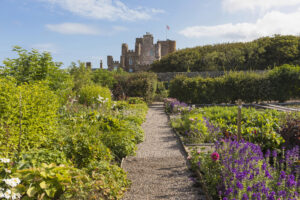
Both properties are run by The Prince’s Foundation, the King’s educational charity, and play vital roles in the organisation’s work to protect rural traditions and promote traditional crafts. At Dumfries House, there is training in skills such as stonemasonry and woodworking, while at The Castle of Mey, the staff are working to preserve traditional breeds of cattle and sheep.
From farmers and gardeners, butlers and stonemasons to designers and artisans, a huge range of people are working at both properties to help achieve the The Prince’s Foundation’s aims or are directly benefiting from its work. Here are just a few of them.
SATINDER KAUR, COLLECTIONS MANAGER, DUMFRIES HOUSE
As collections manager, Satinder Kaur is charged with the maintenance and preservation of the stately home’s fine collection of furniture, art and artefacts. But the other main goal of the work on the Dumfries Estate is education and training in traditional skills.
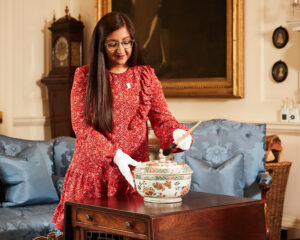
“The main drive initially was to get the house up and running,” says Satinder, “but now our main goal is orientated towards education: there’s woodwork, thatching, and pargeting, or decorative plastering, and at Dumfries House we’re providing a space to bring back these traditional skills. Not only are we teaching these skills, we’re also giving the students a practical opportunity to carry out everything they’ve learned.”
The courses and training available at Dumfries House include a Building Crafts programme that seeks to pass on traditional skills to the next generation, such as thatching, stonemasonry and the design of stained glass. There is also training in horticulture, farming. and textiles and a course that gives young people the experience they need to work in the hospitality industry.
Satinder says that the training has not only benefited the students themselves, who often go on to work at Dumfries House, but it has helped regenerate the local area and protect and preserve the house and its contents. “It’s a privilege to be in charge of such an amazing collection,” she says.
“But Dumfries House is also very important to maintaining these skills, particularly in the west of Scotland. I’m really proud of the work we do here.”
GRAEME BONE, TEXTILES MAKER
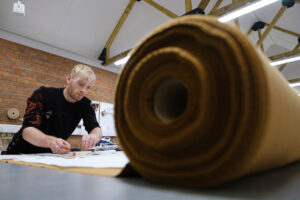
When Graeme Bone left school aged 16, he went straight into the construction industry, but it wasn’t what he wanted to do with the rest of his life. “I wanted to do something where I could use my creativity,” Graeme said, “and at that point I was looking at interior design. But the next step was fashion.”
Graeme, who grew up in the village of Auchinleck near Dumfries House, enrolled on The Modern Artisan, a training programme run by The Prince’s Foundation in partnership with YOOX Net-a-Porter that prepares students for working in fashion and textiles. Having graduated, he is now running his own business making bespoke kilts which sell around the world, including to the US.
Not only has Graeme met the King, who donated tartan to him so he could design a one-off kilt, The Modern Artisan connected him to influential industry figures such as Federico Marchetti, Net-a-Porter’s founder, who he also created a kilt for. Graeme says the training and advice he received at Dumfries House has been invaluable and hopes he can now make a contribution to preserving the important art of kilt-making in Scotland. “It’s been important for the transformation in my life,” he says. “I’m finally getting to where I want to be.”
SHIRLEY FARQUHAR, ADMINISTRATOR, THE CASTLE OF MEY
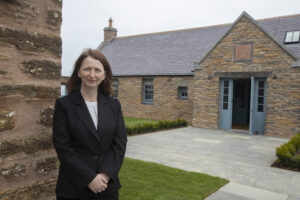
Shirley Farquhar knows all about traditions being passed on because she’s part of a tradition herself. Shirley’s mother, Hazel, has been a guide at The Castle of Mey since 2002 when it first opened to the public and, at 83 years of age, is just about to begin her 22nd season. Shirley is now carrying on the tradition of working at the castle as administrator of The Castle of Mey Trust. As well as the castle, the trust is responsible for the visitor centre and the farm, which has the same stock the Queen Mother used to breed: Aberdeen Angus cattle and North Country Cheviot sheep. There’s also an animal centre that showcases unusual breeds of sheep and poultry and bantams, ducks, and geese, including Buff Orpingtons, a breed kept by the Queen Mother.
Also central to Shirley’s work is the maintenance of the castle itself. “We take the maintenance of the castle very seriously,” she says. “In 2016, there was a redevelopment using traditional methods.
We employed local stonemasons and artisans and built the animal centre from scratch in the vernacular Caithness style using local stone. When we do something, we make sure it’s done in the correct, traditional style.”
CHRIS PARKINSON, HEAD GARDENER, THE CASTLE OF MEY
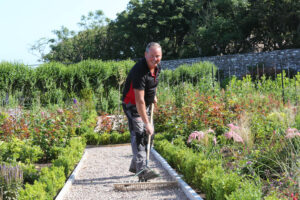
As head gardener, Chris Parkinson is responsible for preserving the traditions of the walled garden the Queen Mother loved so much at The Castle of Mey and growing fruit and vegetables for royal visits – King Charles III was a regular visitor from a young age.
“I came to the castle five years ago and took over the walled garden,” says Chris. “It was kept the way the Queen Mother liked it, done with herbaceous borders and roses, but it was looking pretty tired, so we’ve revived it a little bit, but it’s still kept in the manner it was.”
The garden is run sustainably: the gardeners stay chemical-free, use natural manures, and make their own compost. Chris is also looking after the most northerly royal walled garden in the UK, so he also has to work hard to protect it from wind and rain. He is currently working on a number of projects, such as adding in new arbors, fruit cages and a new peach house: tradition and the future mixed in. “It’s an ongoing project,” he says.
This is an extract. Read the full feature in the May/June 2023 issue of Scotland, available to buy from Friday 14 April.
MORE FROM SCOTLAND MAGAZINE

SCOTLAND MAGAZINE
Published six times a year, every issue of Scotland showcases its stunning landscapes and natural beauty, and delves deep into Scottish history. From mysterious clans and famous Scots (both past and present), to the hidden histories of the country’s greatest castles and houses, Scotland‘s pages brim with the soul and secrets of the country.
Scotland magazine captures the spirit of this wild and wonderful nation, explores its history and heritage and recommends great places to visit, so you feel at home here, wherever you are in the world.